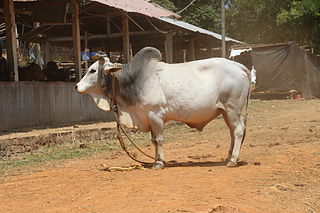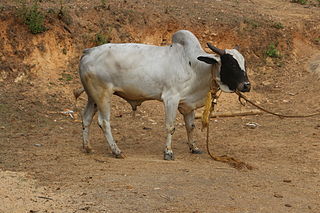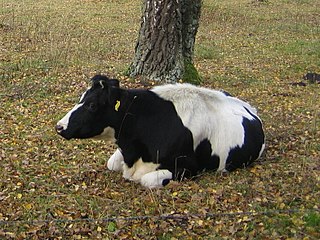
The Mishima is a critically-endangered Japanese breed of beef cattle. It is found only on Mishima Island, some 50 km north-west of Hagi, in Yamaguchi Prefecture, Japan. It is one of six native Japanese cattle breeds, and one of two small populations that have never been cross-bred with Western cattle, the other being the Kuchinoshima breed from Kuchinoshima island in the Tokara Island group.
The Yurino is a dual purpose cattle breed from the Russian Federation, particularly the Mari Republic.
The Taishū or Tsushima is a rare Japanese breed of small horse from Tsushima Island in the Korea Strait, in Nagasaki Prefecture, Japan.
The Ringamålako is an endangered Swedish breed of dairy cattle. It is named for the village of Ringamåla in the southern Swedish county of Blekinge, and is found primarily in southern Sweden. It is similar to the type of Swedish Red-and-White cattle of the 1940s, and is considered a valuable genetic resource.

The Malvi or Malavi, also known as Manthani or Mahadeopuri, is breed of zebu cattle from the Malwa plateau in western Madhya Pradesh, in central India. It is a good draught breed; the milk yield of the cows is low.

The Deoni is an Indian breed of draught cattle. It is named after the taluk of Deoni in the Latur district of Maharashtra state, and is distributed mainly in the Latur, Nanded, Osmanabad and Parbhani districts of the Marathwada region of Maharashtra, as well as the Bidar district of Karnataka.

The Fjäll is a traditional Swedish breed of polled mountain cattle. It was threatened with extinction in the 1970s and 1980s, but recovered after a breed association was formed in 1995, partly thanks to stocks of frozen semen. Microsatellite analysis has shown it to be closely related to the endangered Bohuskulla breed.

The Estonian Red, Estonian: Eesti punane, is an Estonian breed of dairy cattle. It was developed in the second half of the nineteenth century from cross-breeding of local cattle with imported stock of the Angeln, Danish Red and North Slesvig Red breeds. The coat is red, but sometimes it varies from red-white to brown and rarely black.

The State of the World's Animal Genetic Resources for Food and Agriculture is a major report on the breeds of farm livestock in the world. It was published by the Food and Agriculture Organization of the United Nations (FAO) in 2007. It covers mammalian and avian domestic livestock breeds, but does not include fish or honey bees and other invertebrates. It is based on information submitted to the FAO, in the form of reports of participating countries, thematic studies prepared by experts and data on individual breeds submitted to DAD-IS. An annex to the report, the List of breeds documented in the Global Databank for Animal Genetic Resources, gives an estimate of conservation status for all breeds for which sufficient data had been received. The report has been translated into Arabic, Chinese, French, Indonesian, Russian and Spanish.

The Swedish Red-and-White, Swedish: Svensk Röd och Vit Boskap, frequently abbreviated to SRB, is a Swedish breed of dairy cattle. It was created in the 1920s by crossing the Swedish Red Pied and Swedish Ayrshire breeds.
The Swedish Red Pied, Swedish: Rödbrokig Svensk Boskap, frequently abbreviated to RSB, was a Swedish breed of dairy cattle. It is now considered extinct. It was merged in the 1920s with the Swedish Ayrshire breed to create the Swedish Red-and-White, which is one of the principal dairy breeds of Sweden.

The Swedish Red Polled, Swedish: Rödkulla, is a Swedish breed of domestic cattle. It is a dual-purpose breed, raised both for its milk and for its meat.

The Swedish Polled, Swedish: Svensk Kullig Boskap, often abbreviated to SKB, is a Swedish breed of domestic cattle. It was created in 1937 from two different Swedish cattle breeds, the Swedish Red Polled and the Fjäll. Breeders did not accept the new classification, and continued to maintain separate bloodlines as before. Of the two constituent breeds, the Swedish Red Polled received official recognition in 2004, while the Fjäll has divided into two sub-breeds, the Fjällnära Boskap and the Svensk Fjällras.

The Väneko is an endangered Swedish breed of dairy cattle. It is named for the village of Väne-Ryr in the landskap of Västergötland, in western Sweden. It is a traditional domestic Swedish breed, and derives from a group of cattle discovered in the 1990s, at a time when all traditional Swedish horned cattle were thought to have disappeared.

The Swedish Friesian, Swedish: 'Svensk Låglandsboskap', often abbreviated to SLB, is a Swedish breed of dairy cattle. It was established in about 1870 from imports of cattle of Dutch Friesian or German Black Pied type. From about 1970 it has been systematically cross-bred with the American Holstein-Friesian breed, to the point that the original Swedish type may be extinct. The name Swedish Holstein may also be used.It is a type of Swedish cattle breed.

The Japanese Shorthorn is a breed of small Japanese beef cattle. It is one of six native Japanese cattle breeds, and one of the four Japanese breeds known as wagyū, the others being the Japanese Black, the Japanese Brown and the Japanese Polled. All wagyū cattle derive from cross-breeding in the early twentieth century of native Japanese cattle with imported stock, mostly from Europe. In the case of the Japanese Shorthorn, the principal foreign influence was from the Shorthorn, with some contribution from the Ayrshire and Devon breeds.
The Japanese Polled is a critically-endangered breed of small Japanese beef cattle. It is one of six native Japanese cattle breeds, and one of the four Japanese breeds known as wagyū, the others being the Japanese Black, the Japanese Brown and the Japanese Shorthorn. All wagyū cattle derive from cross-breeding in the early twentieth century of native Japanese cattle with imported stock, mostly from Europe. In the case of the Japanese Polled, the principal foreign influence was from the Scottish Angus breed.

The Kuchinoshima is a critically-endangered Japanese breed of small feral cattle. It is found only on Kuchinoshima Island, in the Tokara Islands in Kagoshima Prefecture in southern Japan. It is one of six native Japanese cattle breeds, and one of two small populations that have never been cross-bred with Western cattle, the other being the Mishima breed from Mishima Island north-west of Hagi, in Yamaguchi Prefecture.
















